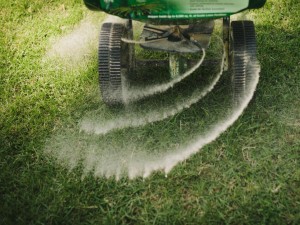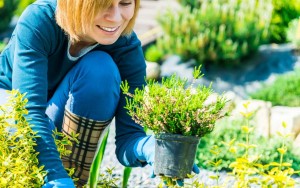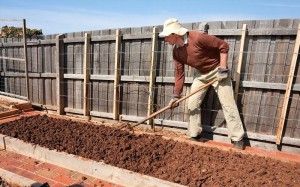Spring cleanup isn’t just for the inside of your house. It’s even more critical to prepare the outside of your home (specifically your lawn and garden) for the growing season. Doing all of these tasks now will ensure that you have a healthy lawn and garden all through the spring and summer months.
1. Spring Cleanup. OK. Old Man Winter has come and gone and, unfortunately, he’s left a bit of trash behind that you need to deal with. Roll up your sleeves, put on some work gloves, grab a rake and start removing: litter, fallen branches and leaves. If you raked your leaves thoroughly in the fall there’s a good chance you’ve avoided the dreaded fungal lawn disease, “snow mold.” But, come spring, a few stray leaves from the late fall months will inevitably appear so, get out the rake and do some “deep raking” to help loosen any dead grass and control thatch.

2. Preventing Weeds Before They Start. It’s always easier to fight weeds before they take hold. That’s where pre-emergent herbicides come into play. Early spring is the time to use one of these, particularly for crabgrass control but, correct timing is essential. Crabgrass seeds germinate when the soil temperature reaches 55-60 degrees Fahrenheit. Short of sticking a thermometer in the ground to check the temperature (!) just keep an eye on your flowering shrubs. Apply your crabgrass-preventing herbicide after the forsythia stops blooming and before the lilacs start. One chemical fertilizer for lawns that many people prefer for its convenience is the “weed and feed” type.

3. Preparing Your Existing Garden Beds. In established perennial beds that performed well the year before, working in some additional compost around your plants to fertilize them, is the best thing you can do. Also, remove weeds as you encounter them plus old, dead growth that you didn’t remove in the fall. No sense in letting them get ahead of you! While on the subject of compost, please note that it’s not just for planting beds. Most all of your plants (including the grass in your lawn and your trees and shrubs) will enjoy a feeding of compost in the spring (later in the year, too, for that matter). The best thing about using compost as a fertilizer is that you never, ever have to worry about burning plants with it. Compost is nature’s slow-releasing fertilizer. If you must use chemical fertilizers, always be careful to follow the application directions, because chemical fertilizers will burn plants when used in excess. Also, remember that it’s very important to keep track of what type of potting soil or topsoil you use as many manufacturers are now adding fertilizers as part of the soil mixtures that you buy.

4. Starting New Garden Beds. To open up brand new planting beds, you have a few options, including: opening new ground, converting lawn space into planting space or building raised beds. If you’ve just opened up a planting bed by breaking new ground, you can be sure that, unfortunately, weeds will find it quickly. That’s why, in some situations, it’s often a good idea to lay a landscape fabric (sometime called a weed barrier) over the ground and cover it with a light layer of mulch. The mulch will protect the landscape fabric from harmful UV rays. If you don’t like using landscape fabric, straw works just as well.

6. Take a Breather. You deserve it. The good news is that once you’ve done all the prep work for a healthy lawn and garden you can get down to the “fun stuff,” which is admiring your beautiful, healthy lawn and enjoying your fragrant, colorful garden. You’ll be the envy of your neighborhood!


0